As we continue our journey to build a stronger, leaner, and more toned physique, we must focus on exercises that target the often-neglected lower chest muscles.
The lower chest is one of the harder areas to train because of the lack of variations available and the limited motion range. This is why you should add these dumbbell exercises to your lower chest workout routine.
You will be amazed how these dumbbell chest exercises can target those hard-to-reach areas and leave you feeling empowered and confident.
And the best part? It’s relatively easy to do, even for beginners.
This post will show you the 7 best lower-chest dumbbell exercises and give you the tricks, tips, and advice you need to master them.
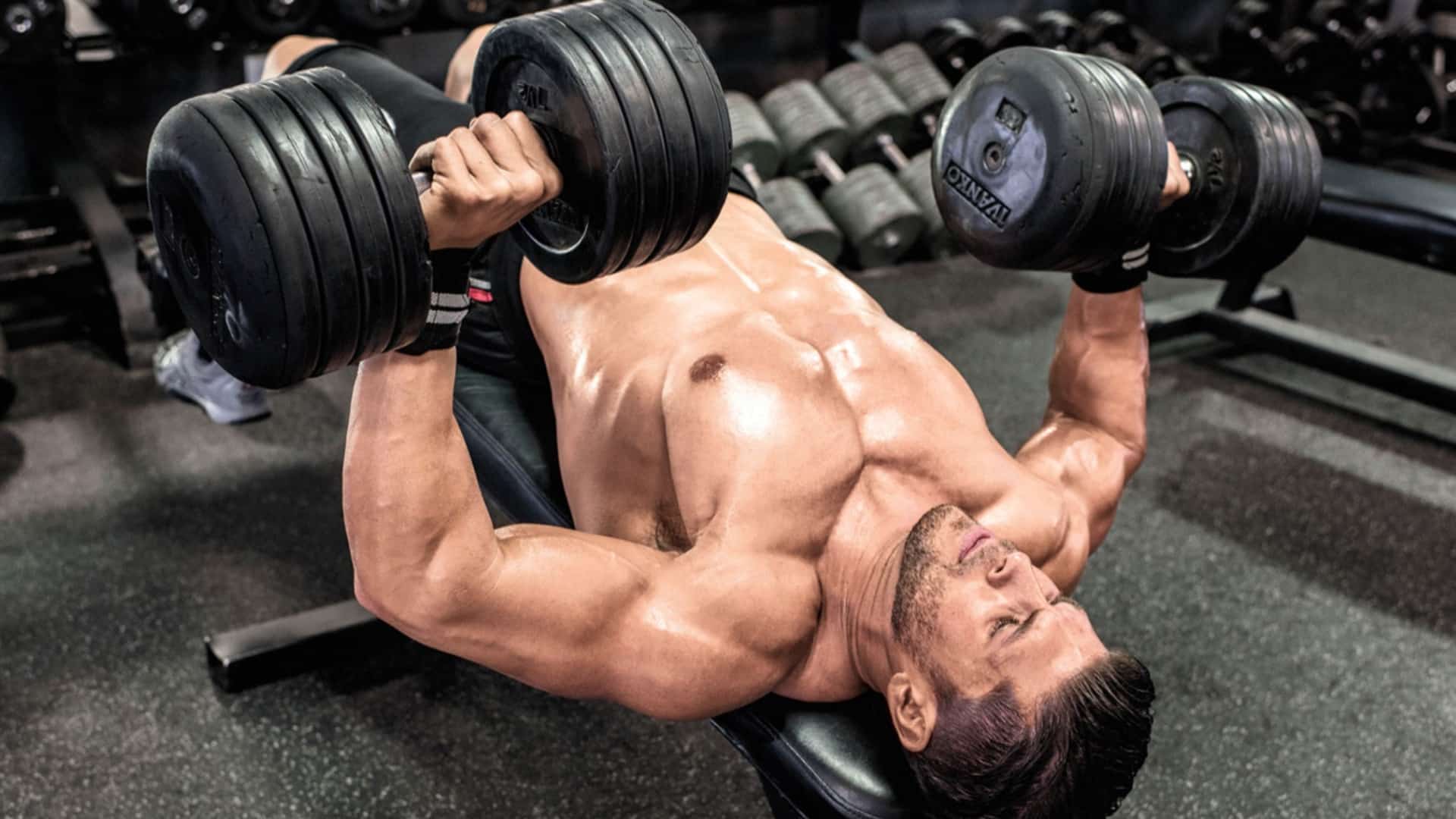
- 7 Best Lower Chest Dumbbell Workouts
- 1. Decline Dumbbell Press
- 2. Decline Dumbbell Fly
- 3. Decline Hammer-Grip Dumbbell Bench Press
- 4. Dumbbell Pullover
- 5. One Arm Decline Dumbbell Fly
- 6. Dumbbell Decline Twist Fly
- 7. One Arm Decline Dumbbell Chest Press
- Train Lower Chest With Dumbbells (With Workout Routines)
- Best Bench Angle To Train Lower Chest
- Reps Range For Mass and Strength
- Advanced Techniques To Progressively Overload The Muscles
- Beginner-Friendly Dumbbell Lower Chest Plan
- Intermediate Dumbbell Lower Chest Workout
- Lower Chest Muscle (Anatomy)
- FAQs
- Lower chest workout with dumbbells no bench
- Can you target the lower chest?
- What are the best lower chest exercises with dumbbells?
- Is the lower chest important?
- How to isolate lower chest workout?
- Lower chest is not growing
- Can I Do Lower Chest Exercises With Dumbbells?
7 Best Lower Chest Dumbbell Workouts
Here is the list of the best dumbbell exercises for the lower chest, which help to train the chest at various angles and strengthen and build a well-developed chest.
1. Decline Dumbbell Press
The decline dumbbell bench press aka dumbbell decline press is an upper body workout that engages the lower pec muscles, the triceps, and the anterior deltoid muscles of the shoulders.
Research indicates that the correct angle for the decline bench press should be 15–30 degrees, declining from flat to target the lower chest.
It may seem like a small angle, but it is the proper angle for training your lower pecs and minimizing the effect on the anterior deltoid muscles.
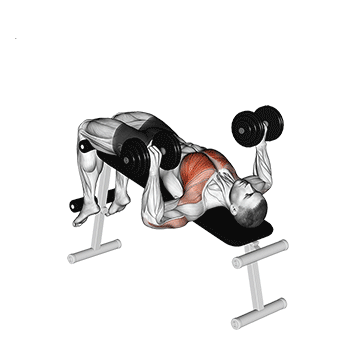
How To Do
- First, adjust the decline bench press angle to 15-30 degrees.
- Then, lie on your back with your face upward.
- With your form right, grab the dumbbell.
- Hold the weights above you at shoulder height.
- Now, extend the weights to the top overhead, feeling a good chest muscle contraction.
- Lower the dumbbells to the starting position and feel a good stretch in your lower pecs.
Tips
- Keep a controlled motion and avoid jerky movements.
- Always use weights that you can handle comfortably.
- Perform them before triceps in any workout.
2. Decline Dumbbell Fly
The decline dumbbell chest fly is a variation of the dumbbell fly that is performed on a decline bench, which is set at a downward slope of around 15 to 30 degrees.
Unlike regular flys, the decline angle targets that stubborn lower chest like nothing else. Plus, it gives you an incredible stretch, which is key for muscle growth. And here’s a bonus: it takes some pressure off your shoulders compared to flat bench flys.
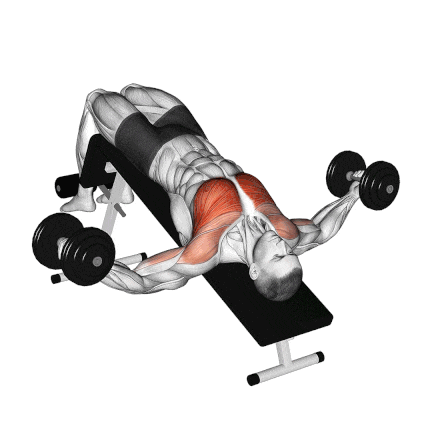
How To Do Decline Dumbbell Fly
- Adjust your bench to a 15-30 degree decline.
- Grab a dumbbell in each hand and lie on your back on a decline bench. Hook your feet into the foot pad or roller.
- Hold the dumbbells above your chest, arms slightly bent.
- Slowly lower the dumbbells in an arc motion to the sides of your chest. Feel that stretch across your chest.
- When your arms are parallel to the ground (or as far as feels comfortable), pause for a second.
- Then, bring those dumbbells back up, squeezing your chest as you go.
- Do 10–15 reps for 3–4 sets
Tips
- Keep the movement slow and controlled.
- Make a mind-muscle connection and focus on the stretch and squeeze.
- Use a slight decline, such as 30 degrees. Extremes are never the best option.
- Don’t let the weights touch at the top; this keeps tension on your chest muscles.
- Don’t try to go too heavy too soon. It’s better to use a lighter weight and focus on proper form than to risk injury with a heavier weight.
3. Decline Hammer-Grip Dumbbell Bench Press
The decline hammer-grip dumbbell bench press is a compound exercise that primarily targets the lower chest. However, the triceps and shoulders are secondary movers during the workout and also receive heavy stimulation.
Using a neutral grip is a safe alternative to the pronated grip as it protects the shoulder joints, which is a great advantage.
Honestly, when I first tried this, it felt weird. The hammer grip threw me off, and I thought I was doing it wrong. But stick with it. Once it clicks, you’ll feel it working your chest and triceps like crazy. So, include it in your chest routine for great results.
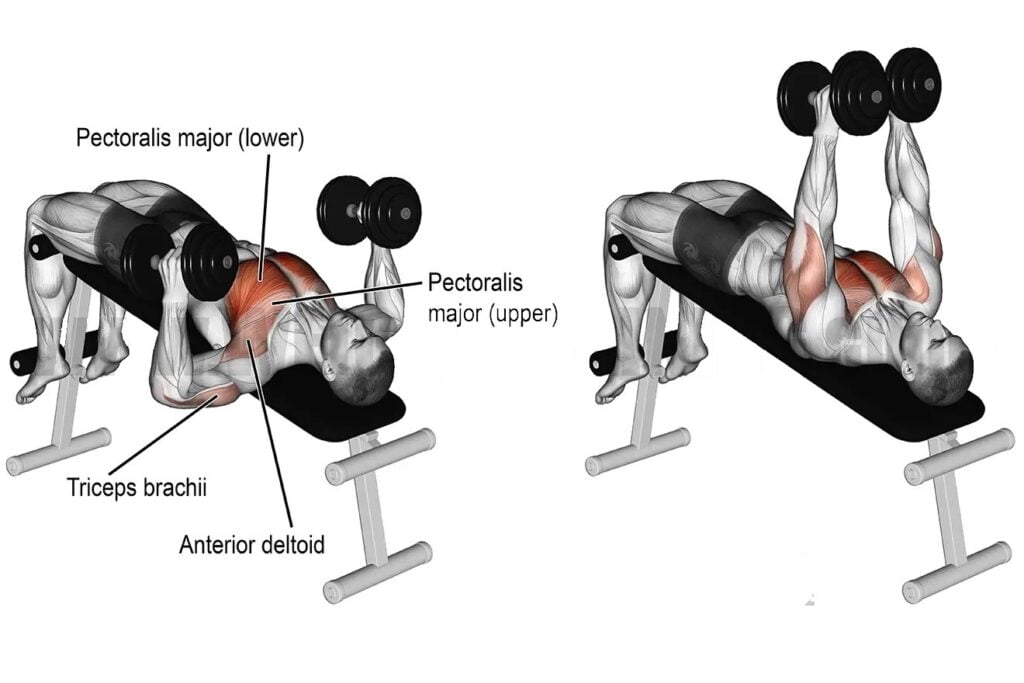
How To Do
- Grab a dumbbell with a neutral/hammer grip in each hand and lie on a decline bench.
- Lie back on the bench, feet secured under the leg supports. Hold the dumbbells at chest level with palms facing each other. This is your hammer grip.
- Push those dumbbells up towards the ceiling. Keep your wrists straight and your elbows tucked at about a 45-degree angle to your torso.
- At the top, give those pecs a little extra squeeze.
- Inhale as you lower the dumbbells to the starting position or until you feel a mild stretch in your chest or shoulders.
Tips
- Do not lock out your elbows during the exercise’s concentric (Positive) phase.
- Keep those elbows tucked. Flaring them out puts unnecessary stress on your shoulders.
- Breathe out as you press the weights up and inhale as you lower them
4. Dumbbell Pullover
The dumbbell pullover is one of those rare exercises that work both your chest and your back simultaneously. This makes it incredibly efficient for building upper body strength and size.
But what I really love about pullovers is the incredible stretch they give your chest. When you lower the dumbbell behind your head, you’re really opening up those pecs.
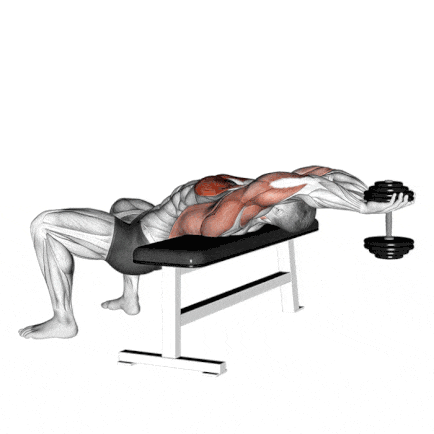
How To Do
- Lie perpendicularly on a flat bench with only your upper back and shoulders supported.
- Your feet should be flat on the floor, and your hips should be lower than your chest.
- Grasp a dumbbell with both hands and get it straight over your chest.
- Slowly lower the dumbbell in an arc motion behind your head. Lower until you feel a good stretch in your lats and chest.
- Squeeze your chest and lats to bring the dumbbell back to the starting position above your chest.
5. One Arm Decline Dumbbell Fly
The one arm decline dumbbell fly is a unilateral variation of the chest fly used to target the chest muscles. It is used by those who want to focus on one side of their chest, working at a time.
The decline angle used for the dumbbell chest fly specifically targets the lower chest.
When performing the one-arm dumbbell fly, it is important to start on the weaker side of your chest.
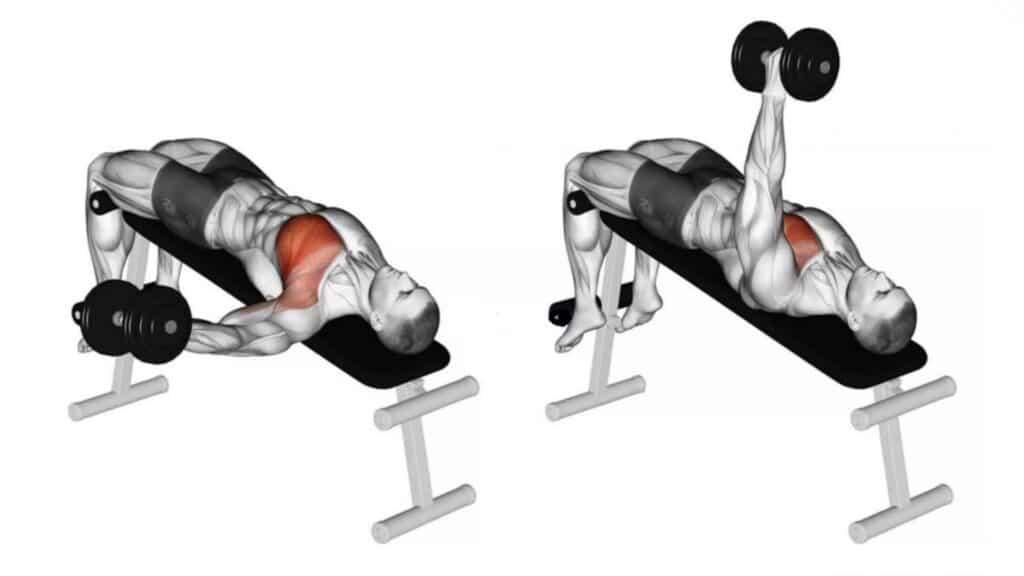
How To Do
- Grab a dumbbell in one hand and lie on your back on a decline bench. Hook your feet into the foot pad or roller.
- Extend the dumbbell above your chest.
- Slowly lower your arm to your side until your wrist reaches about shoulder level or slightly above.
- Bring your arm back toward the midline of your body, focusing on using your lower pec muscles to draw them back together.
- Repeat for as many reps and sets as desired.
Tips
- Keep the movement slow and controlled.
- Always keep a slight bend in the elbows and never lower the weight to the point where you get any sort of pain and pressure at the front of the shoulder joint.
6. Dumbbell Decline Twist Fly
The decline dumbbell twist fly is a slight variation of the decline dumbbell fly.
The movement targets the chest muscles, with an emphasis on the lower pecs. It also indirectly targets the muscles of the shoulder and triceps.
The slight added twist of the decline dumbbell twist fly works the lower chest muscles more effectively.
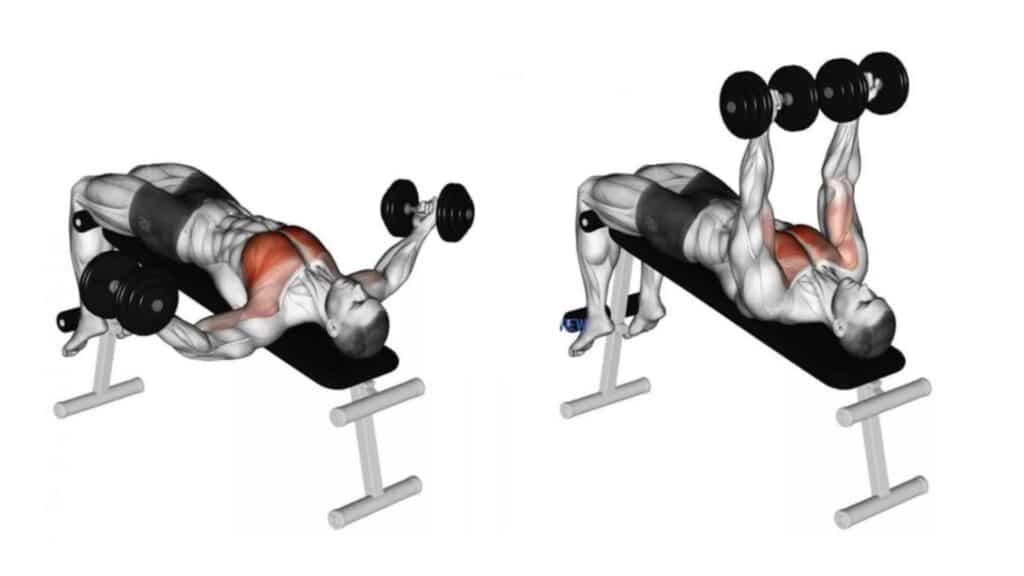
How To Do
- Grab a dumbbell with a neutral grip in each hand and lie on a decline bench.
- Hold the weights above you at shoulder height.
- Slightly retract your shoulder blades, unlock your elbows, and slowly lower the dumbbells laterally while maintaining the angle at your elbow.
- Avoid touching or banging the dumbbells together at the top of each repetition to keep constant tension.
- Once the dumbbells reach chest level, reverse the movement by twisting the wrist.
- Start the next repetition by untwisting, returning to a neutral position, and continuing until the set is complete.
7. One Arm Decline Dumbbell Chest Press
This move is a fantastic variation that brings a whole new dynamic to your lower chest workouts.
When you work one arm at a time, you can more effectively isolate and activate your chest muscles. This will fix any muscle imbalances and ensure that both sides are equally strong and developed.
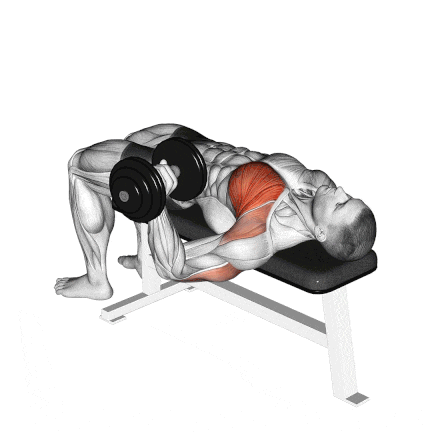
How To Do
- Adjust the bench at around 15-30 degrees of decline
- Grab a pair of light or moderately heavy dumbbells in one arm.
- Lie back on the bench, securing your feet under the leg supports.
- Hold the dumbbell to your side, but avoid flaring your elbows out.
- Push the dumbbell upward until your arm is fully extended but not locked out.
- Exhale and slowly bring the dumbbell back to your side.
Train Lower Chest With Dumbbells (With Workout Routines)
Dumbbells may be better for training your lower chest than barbells, as they offer a wider range of motion and allow for a more intense workout. It is also beneficial for achieving hypertrophy and strength.
However, with dumbbells, you can easily increase the intensity of your workout on your own. For example, if you want to do drop sets on the barbell bench press, you’ll need a partner to drop the weight from the barbell.
Best Bench Angle To Train Lower Chest
To train the lower chest (sternal head), you must change the angle of your press to emphasize the lower part of the chest. You do this by performing exercises on a decline bench.
Research indicates that the correct angle for the decline bench press should be 15–30 degrees declined from flat to target the lower chest.
Reps Range For Mass and Strength
- For muscle endurance: Aim for 3-4 sets of 12-15 reps, with moderate resistance.
- For muscle strength: Aim for 3-5 sets of 6-10 reps, with a heavier amount of resistance.
- For muscle hypertrophy (increased muscle size): Aim for 3-4 sets of 8-12 reps, with a moderate to heavy amount of resistance.
It is always best to start with a lower number of reps and sets, and then gradually increase as your strength improves.
Advanced Techniques To Progressively Overload The Muscles
To strengthen your lower chest, you should try increasing the intensity of your workout.
- Drop-sets,
- forced reps, and
- The pause-and-go method
Beginner-Friendly Dumbbell Lower Chest Plan
If you’re new to lifting weights, don’t worry. This beginner-friendly chest workout routine is a great place to start.
When this gets easy, choose a heavier free weight. After you’ve upped your weight several times and feel strong in the movements below, move on to the intermediate routine.
| Exercise | Sets | Reps | Rest |
|---|---|---|---|
| Decline Dumbbell Press | 4 | 8-12 | 60-90 sec |
| Decline Dumbbell Fly | 4 | 8-10 | 60-90 sec |
| Dumbbell Pullover | 3 | 8-10 | 60-90 sec |
Intermediate Dumbbell Lower Chest Workout
If you are an intermediate level or have outgrown the beginner routine, try the intermediate chest workout routine below.
Regardless of how many reps your programming is calling for, you should be unable to complete the last one with proper form.
| Exercise | Sets | Reps | Rest |
|---|---|---|---|
| Decline Hammer Grip Press | 4 | 8-10 | 60-90 sec |
| Single Arm Decline Fly | 4 | 8-12 | 60 sec |
| Decline Dumbbell Press | 3 | 8-10 | 60-90 sec |
| Dumbbell fly | 3 | 12-15 | 60 sec |
Lower Chest Muscle (Anatomy)
We need to examine the chest anatomy and training methods more closely to train the lower chest effectively.
The chest muscles consist of the pectoralis major and the pectoralis minor.
The pectoralis major is the primary muscle of the chest. It is generally divided into two main parts:
- The clavicular part is the smaller, upper portion, which originates from the first half of your clavicle. This is what we usually mean by the upper chest.
- The sternocostal part is the larger, lower part of your chest that mainly comes from your sternum (and to a small degree from your upper abdominal sheath and ribs). This is your middle and lower chest.
The pectoralis minor is the triangle-shaped muscle located under the pectoralis major, a layer deeper, and draws the shoulder blades down and forward.
FAQs
Lower chest workout with dumbbells no bench
- Dumbbell Floor Press
- Dumbbell Pullovers (on the floor)
- Floor Dumbbell Chest Flyes
- Glute bridge dumbbell flyes
- Dumbbell Deficit Push-Up
- Dumbbell Svend Press
- Dumbbell Single-Arm Floor Fly
- Floor Dumbbell Squeeze Press
- Dumbbell Push-Up with Alternating Arm Raise
Can you target the lower chest?
Yes, but training your lower chest is not as straightforward as training other muscles, such as your biceps. You have to choose the exercise that directly targets the lower chest muscles.
What are the best lower chest exercises with dumbbells?
There are many good exercises with dumbbells that work your lower chest. The decline dumbbell bench presses are one of the best lower chest exercises. You could also add decline dumbbell flies.
If you really want to improve your lower pecs, this adjustable decline bench is your new best friend.
Is the lower chest important?
Yes, the lower chest is important for building the lower pec.
- One primary benefit is that they can specifically target the lower pec muscles, enhancing the chest’s size, strength, and definition.
- Focusing on the lower chest can make your chest look more balanced and symmetrical.
- Chest exercises help increase overall strength and power. The chest muscles are some of the largest in the body, and working them out can significantly enhance strength and power.
How to isolate lower chest workout?
The lower portion of your chest is part of a larger muscle that activates during most, if not all, chest-related exercises.
Still, you can emphasize the lower chest through better exercise selection. Include exercises like:
- Decline Dumbbell Bench Press
- Decline Dumbbell fly
Lower chest is not growing
If you do not properly train (undertrain) a lower chest muscle, it will not grow because it will not receive adequate stimulation. However, if you overtrain a muscle, it will not recover and will not grow. Adequate stimulation is required to grow the chest.
You should train your lower chest 1 to 2 times per week to build mass and strength. If your goal is muscle hypertrophy, then you should do 8-12 repetitions per set.
Can I Do Lower Chest Exercises With Dumbbells?
Any lower chest move you can do with a barbell can be done with dumbbells. Below are some of our favorites, many of which are classic moves you are probably already familiar with, but have been given a clever twist that yields even greater gains.
It’s time to try out the lower chest workout with dumbbells. Some people might think that training with dumbbells is outdated and ineffective.
However, dumbbell chest workouts have shown benefits over other chest exercises due to their increased range of motion and ability to intensify them.
Sources
- Saeterbakken, A. H., et al. (2017). The effects of bench press variations in competitive athletes on muscle activity and performance.

Manish is a NASM-certified fitness and nutrition coach with over 10 years of experience in weight lifting and fat loss fitness coaching. He specializes in gym-based training and has a lot of knowledge about exercise, lifting technique, biomechanics, and more.
Through “Fit Life Regime,” he generously shares the insights he’s gained over a decade in the field. His goal is to equip others with the knowledge to start their own fitness journey.

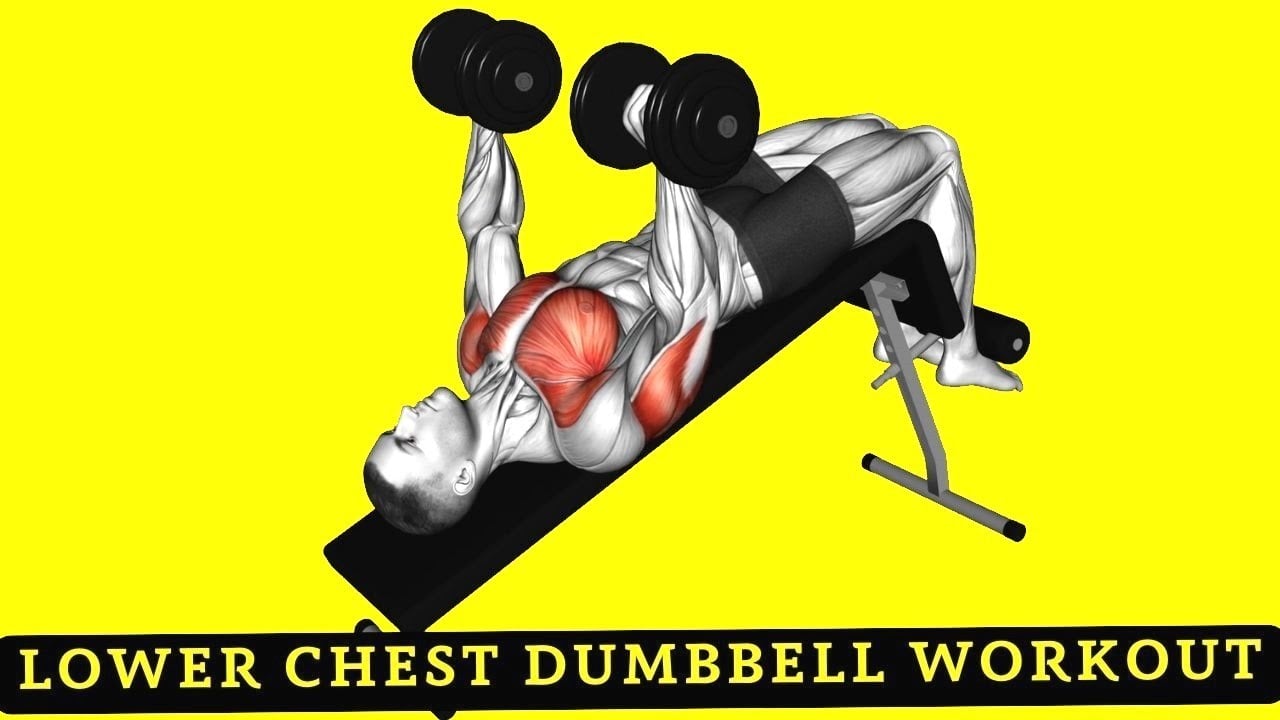
I love this post! I’m a beginner and this is really helpful.
I love these lower chest exercises! They are really effective at building muscle.
Just started incorporating the incline dumbbell press into my workout routine and I’ve already noticed a significant increase in muscle definition on my lower chest. Thanks for the great tips!
Great post! I’ve been looking for effective lower chest workouts to incorporate into my routine, and these dumbbell exercises look perfect. I can’t wait to try them out! Any tips on sets and reps for beginners?